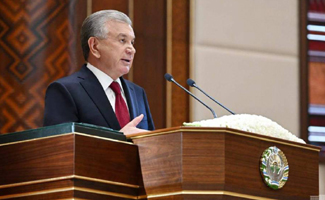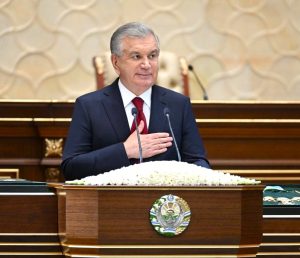
President of Uzbekistan Shavakat Mirzivoyev re-elected and took an oath during the solemn Ceremony of the Inauguration
After the country’s first constitutional referendum on 30 April, comprising major constitutional amendments, the Uzbek population headed again to the voting stations on Sunday 9 July.
Throughout the whole of last year, the population of Uzbekistan had been consulted on how they would like their country to be in the years to come. The process was called the NEW UZBEKISTAN. The amendments were accepted in the referendum with over 90% in support of them.
The presidential election of 9 July was one of the direct results of the constitutional change. There were several candidates running for election, but for any observer it seemed impossible to win against the incumbent — and now re-elected — president. He has done a very good job during his previous term, and everybody expects this will continue to be the case.
Uzbekistan legislation requires at least 33% of eligible voters to take part in the presidential elections, otherwise, the elections will be pronounced invalid. The law also provides for a second round if none of the candidates receives more than 50% of the vote.
 The President was re-elected with 87.05 % of the votes. The participation was higher in the regions than in Taskhent, but this is because many Uzbeks go back to their home cities to vote. The elections were well organized, and there was no criticism from any of the observers. It seemed logical — and completely obvious — to the many observers that the current president would be re-elected, given his excellent track record.
The President was re-elected with 87.05 % of the votes. The participation was higher in the regions than in Taskhent, but this is because many Uzbeks go back to their home cities to vote. The elections were well organized, and there was no criticism from any of the observers. It seemed logical — and completely obvious — to the many observers that the current president would be re-elected, given his excellent track record.
The following day, 10 July, the country’s Central Election Commission published the preliminary results showing the sweeping victory of President Shavkat Mirziyoyev, who got 87.05% of the votes. More than 15 million voters turned out for the elections.
As the result was being declared, letters of congratulations came from all over the world, and especially from the neighboring countries. President Kassym-Jomart Tokayev of Kazakhstan was the first to congratulate his colleague on the victory. President Tokayev described the results of the presidential election as proof of people’s support of the current Uzbek president’s political program aimed at ensuring Uzbekistan’s sustainable growth, stability and prosperity, the president’s press service said. The Chinese leader Xi Jinping sent his congratulations as well and praised Mirziyoyev’s leadership, saying, « I am willing to work with you to promote the continuous development of the China-Uzbekistan comprehensive strategic partnership and inject new impetus into the construction of a China-Uzbekistan community with a shared future, ».

During the Inauguration, the President outlined strategic goals for the next 7 years. These are the improvement of legislative and executive power, the creation of a compact and efficient management system, the development of the social sphere, the expansion of opportunities for entrepreneurship, and the increase in jobs and incomes of the population.
Shavkat Mirziyoyev announced the consistent continuation of a deeply thought-out foreign policy and economic diplomacy. The main goal will be to strengthen relations with the states of the region and to raise cooperation with foreign partners and international organizations to a new level. Solving the problems of ecology and environmental protection, as well as the shortage of water resources, will remain an urgent task.
Being a neutral, independent observer, I have had the pleasure of visiting Uzbekistan numerous times over the years, and what I see and hear is that the population has a rising standard of living. Economic growth is stable. President Shavakat Mirzivoyev has opened up the country of 35 million people to foreign trade and investment while also easing restrictions on religious and political freedoms. This was my third presidential election, something a volunteer in Bukhara so kindly reminded me of. I visited several voting stations, and they were as usual very well organized. Owing to the heat, most people came early in the morning, or late in the day, just before the closure of the voting stations. In the middle of the day, when the temperature reached 43 degrees Centigrade, many people preferred to wait until the late afternoon before casting their vote.





